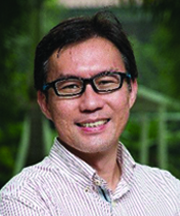
Dr Ho Chaw Sing is the co-founder and Managing Director of NAMIC (National Additive Manufacturing Innovation Cluster), a Singapore government platform initiative to catalyse innovation and scale industrial adoption of digital additive manufacturing technologies. Since its inception in late 2015, NAMIC has raised several millions in public-private funding to support various AM initiatives across several industry sectors. Before joining the public sector, he spent several years with HP Singapore and Chartered Semiconductor, where he undertook various executive roles in technology and product development, as well as supply chain manufacturing operations. An advocate for technology for good and 3D Printing’s role in sustainable development and manufacturing, Chaw Sing has participated in numerous forums, including at the World Bank Group, Development Research Centre China, and the World Economic Forum - Centre for the Fourth Industrial Revolution. He is passionate about nurturing deep tech start-ups.
Dr Ho Chaw Sing is an Adjunct Associate Professor at the National University of Singapore Faculty of Engineering, and lectures on Industry 4.0 topics in the areas of product design, cyber-physical integration and digital manufacturing technologies. He co-chairs the Standards Technical Committee on Additive Manufacturing under the Singapore Standards Council, and serves in various Advisory and Steering committees such as ASTM’s International Additive Manufacturing Centre of Excellence (AM CoE). A prolific inventor in his early career, he holds 48 US/international patents. He earned his doctorate (Ph.D) in Electrical and Computer Engineering, and has a Bachelor’s (honours) degree in Electrical Engineering with a major in Microelectronics, both from the National University of Singapore.
Presentation Synopsis
Future of Healthcare : 3D Printing for Personalized Medicine
3D printing (also known as Additive manufacturing) is increasingly playing an important role in a myriad of healthcare applications, spanning pre-surgical models, dental, prosthetics, orthopedics, drugs, and even tissue engineering. With recent breakthroughs in bioprinting platforms that can 3D print vascularized tissues using patients’ cells and biological materials, functional 3D printed organs is a distinct possibility in the foreseeable future. According to the World Health Organization, the proportion of the world’s population above 60 will double from 12% to 22% between 2015 to 2050. All countries face major challenges to ensure that their healthcare systems are ready to cope with this demographic shift. There is a pressing need to develop and adopt better patient-specific solutions realized by 3D printing to help prolong the active lifestyle for the aged. Falling 3D printing costs and better clinical outcomes will drive greater deployments of 3D printed medical solutions — whether that means community hospitals adopting a point-of-care model empowering surgical teams with dedicated 3D printing facilities, or mobile medical units bringing state-of-the-art healthcare solutions to underserved populations. 3D printing is a perfect solution for limited runs of products targeted at smaller and less profitable groups of patients with unmet needs. Increased awareness and acceptance by clinicians, as well as endorsement by medical regulators and policy makers are critical to progress 3D printing from niche to mainstream adoption for the future of personalized medicine. This talk will provide an overview of the latest in 3D printing technology advancements and addressable market opportunity, with suggestions to catalyze its adoption for the benefit of the patient community within this decade.